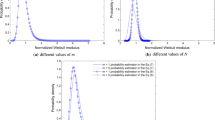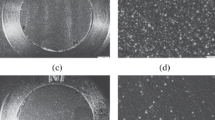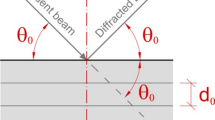Abstract
According to ASTM E1426, X-ray elastic constants (XEC) are measured using four-point bending fixtures on specimens with a length-to-width ratio of at least four (with a width sufficient enough for a strain gage to be mountable) and width-to-thickness ratio of greater than one. Typically, recommended sample dimensions for four-point fixtures are approximately 102 mm in length, 19 mm in width and 1.5 mm in thickness. However, the requirement of such larger dimensions limits sample extraction in engineering components with limited cross-section. Analytically, XECs can be estimated using either Voigt, Reuss, Kroner and modified Kroner models with single-crystal elastic constants (SCEC) of any material/alloy of interest as inputs. Even though several procedures for estimating SCECs are demonstrated in the literature, the lack of portability in them demands alternate approaches for measurement. Therefore, in this study, an alternate approach of estimating XEC constants from a cubic sample of Nickel-based super-alloy polycrystalline material was demonstrated. SCECs, C11, C12 and C44 were extracted by minimizing the difference between experimentally measured and analytically predicted ultrasonic parameters such as longitudinal velocity, shear velocity and attenuation coefficients. Further, using the predicted SCECs, the XECs were estimated using a modified Kroner approach. It was observed that the proposed approach predicted XECs within 3% error compared to those measured using ASTM E1426.




Similar content being viewed by others
References
M.E. Fitzpatrick, A.T. Fry, P. Holdway, F.A. Kandil, J. Shackleton, and L. Suominen, NPL good practice guide No.52 determination of residual stresses by σ diffraction (2005)
I.C. Noyan and J.B. Cohen, Residual Stress Measurement by Diffraction and Interpretation, Springer, New York, 1987.
ASTM E 1426-14, Standard test method for determining the effective elastic parameter for σ diffraction measurements of residual stress, pp 2019e1
A. Heldmann, M. Hoelzel, M. Hofmann, W. Gan, W.W. Schmahl, E. Griesshaber, T. Hansen, N. Schell, and W. Petry, Diffraction-based determination of single-crystal elastic constants of polycrystalline titanium alloys, J. Appl. Crystallogr.Crystallogr., 2019, 52, p 1144–1156.
B.K.D. Gairola and E. Kroner, A simple formula for calculating the bounds and the self-consistent value of the shear modulus of a polycrystalline aggregate of cubic crystals, Int. J. Eng. Sci., 1981, 19, p 865–869.
R. De Wit, Diffraction elastic constants of a cubic polycrystal, J. Appl. Crystallogr.Crystallogr., 1997, 30, p 510–511.
Y.W. Zhang, S.J. Li, E.G. Obbard, and H. Wang, Elastic properties of Ti–24Nb–4Zr–8Sn single crystals with bcc crystal structure, Acta Mater. Mater., 2011, 59, p 3081–3090.
D.J. Safarik and R.B. Schwarz, Elastic constants of amorphous and single–crystal Pd40Cu40P20, Acta Mater. Mater., 2007, 55, p 736–746.
D.K. Patel, H.F. Al-Harbi, and S.R. Kalidindi, Extracting single-crystal elastic constants from polycrystalline samples using spherical nanoindentation and orientation measurements, Acta Mater. Mater., 2014, 79, p 108–116.
P. Haldipur, F.J. Margetan, and R.B. Thompson, Estimation of single-crystal elastic constants from ultrasonic measurements on polycrystalline specimens, Rev. Quant. Non Destr. Eval., 2004, 23, p 1061.
P. Mylavarapu, K. Karuparthi, and J.P. Gautam, A non destructive methodology of estimating single crystal elastic constants, in Proceedings of 8th International Symposium on NDT in Aerospace, Nov 3-5 (2016)
J.M.J. Toonder and J.A.W. van Dommelen, The relation between single crystal elasticity and the effective elastic behaviour of polycrystalline materials: theory, measurement and computation, Model. Simul. Mater. Sci. Eng.Simul. Mater. Sci. Eng., 1999, 7, p 909.
F.E. Stanke and G.S. Kino, A unified theory for elastic wave propagation in polycrystalline materials, J. Acoustic Soc. Am., 1984, 75, p 665.
A. Bhattacharjee, A.L. Pilchak, O.I. Lobkis, J.W. Foltz, S.I. Rokhlin, and J.C. Williams, Correlating ultrasonic attenuation and microtexture in a near-alpha titanium alloy, Metall. Mater. Trans. A, 2011, 42, p 2358.
Acknowledgments
The author is grateful to Director, DMRL for the support provided during the course of this study. Special thanks are due to Mr. M. Sateesh Kumar, STA ‘B’ for the experimental support extended during the study. The author would also like to acknowledge the assistance provided by Mr. K.K.Phani Kumar, Mr. Anmol Sharma and Mr. Aryan while developing the MATLAB codes used in this study.
Author information
Authors and Affiliations
Corresponding author
Additional information
Publisher's Note
Springer Nature remains neutral with regard to jurisdictional claims in published maps and institutional affiliations.
This invited article is part of a special topical issue of the Journal of Materials Engineering and Performance on Residual Stress Analysis: Measurement, Effects, and Control. The issue was organized by Rajan Bhambroo, Tenneco, Inc.; Lesley Frame, University of Connecticut; Andrew Payzant, Oak Ridge National Laboratory; and James Pineault, Proto Manufacturing on behalf of the ASM Residual Stress Technical Committee.
Rights and permissions
Springer Nature or its licensor (e.g. a society or other partner) holds exclusive rights to this article under a publishing agreement with the author(s) or other rightsholder(s); author self-archiving of the accepted manuscript version of this article is solely governed by the terms of such publishing agreement and applicable law.
About this article
Cite this article
Mylavarapu, P. Estimation of X-Ray Elastic Constants: An Alternative Approach. J. of Materi Eng and Perform 33, 4170–4177 (2024). https://doi.org/10.1007/s11665-024-09279-9
Received:
Revised:
Accepted:
Published:
Issue Date:
DOI: https://doi.org/10.1007/s11665-024-09279-9




